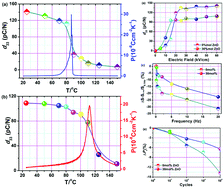Lead-free BNT-based composite materials: enhanced depolarization temperature and electromechanical behavior
Abstract
The development of (Bi0.5Na0.5)TiO3-based solid solutions with both high depolarization temperature Td and excellent piezoelectric and electromechanical properties for practical application is intractable because improved thermal stability is usually accompanied by a deterioration in piezoelectric and electromechanical performance. Herein, we report a 0–3 type 0.93(Bi0.5Na0.5)TiO3–0.07BaTiO3 : 30 mol%ZnO composite (BNT-7BT : 0.3ZnO), in which the ZnO nanoparticles exist in two forms, to resolve the abovementioned long-standing obstacle. In this composite, Zn ions fill the boundaries of BNT-7BT grains, and residual Zn ions diffuse into the BNT-7BT lattice, as confirmed by XRD, Raman spectroscopy, and microstructure analysis. The BNT-7BT composite ceramics with a 0–3 type connectivity exhibited enhanced frequency-dependent electromechanical properties, fatigue characteristics, and thermal stabilities. More importantly, low poling field-driven large piezoelectric properties were observed for the composite ceramics as compared to the case of the pure BNT-7BT solid solution. A mechanism related to the ZnO-driven phase transition from the rhombohedral to tetragonal phase and built-in electric field to partially compensate the depolarization field was proposed to explain the achieved outstanding piezoelectric performance. This is the first time that the thermal stability, electromechanical behavior, and low poling field-driven high piezoelectric performance of BNT-based ceramics have been simultaneously optimized. Thus, our study provides a referential methodology to achieve novel piezoceramics with excellent piezoelectricity by composite engineering and opens up a new development window for the utilization of conventional BNT-based and other lead-free ceramics in practical applications.



 Please wait while we load your content...
Please wait while we load your content...